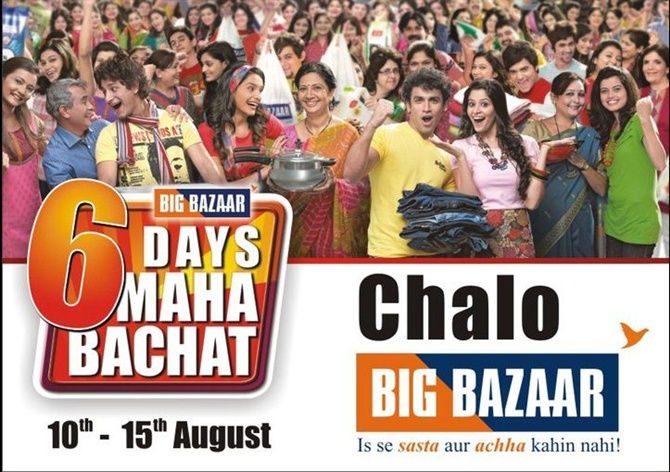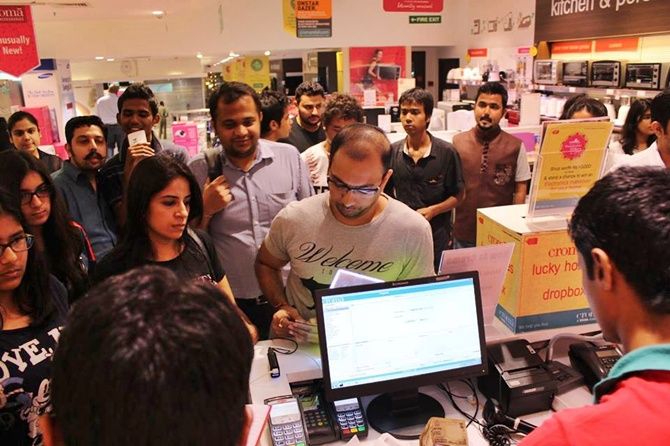
With the festive season underway, retailers in the online and the offline world need to prepare well to offer the best deals to consumers and earn trust.
Monday, October 6, 2014, was supposed to be India's answer to America's 'Cyber Monday'. It was the day Indian e-tailing giant Flipkart unleashed its Big Billion Day sale, promising unthinkably deep discounts across a host of categories.
The day ended up making history for all the wrong reasons - the website's server crashed frequently, there were complaints of fraudulent pricing, stocks ran out within seconds of the sale launch, there were payment and delivery glitches, and to top it all, an unsatisfactory response mechanism from customer care.
In short, Murphy's Law operated in full force - to Flipkart's injury and chagrin. Founders Sachin Bansal and Binny Bansal - who had claimed to clock $100 million worth of sales that day - were forced later to issue apology emails to their irate customers for not living up to expectations.
Juxtapose this against the success of Chinese e-tailer Alibaba's 'Singles Day' sale (hosted every November 11 since 2009 to allow singles to pamper themselves). The company earned more than $5.75 billion in its 2013 sale - a record for a single day anywhere in the world, almost three times the sales of American Cyber Monday 2012.
Backed by impeccable logistics and technology support, 'Singles Day' in 2013 witnessed 254 million transactions and 402 million unique visitors - two-thirds of China's online population, creating a benchmark for the world.
Like everything else in business, the success of a sale of this scale boils down to delivering on customer expectations that you have set. In India, festivals and shopping go hand in hand - several brands garner 20-40 per cent of their annual sales during Diwali season alone.
A retailer, whether it is an e-commerce website or a physical store, needs to be doubly careful about what he promises during a 'festive' sale: the damages from a sale gone wrong can be irreparable.
 In Flipkart's defense, it isn't alone in such a fiasco - even physical retailers globally have witnessed property damage, severe injuries, even deaths, due to unexpected crowd surges, as Devangshu Dutta, chief executive at retail consultancy Third Eyesight, puts it.
In Flipkart's defense, it isn't alone in such a fiasco - even physical retailers globally have witnessed property damage, severe injuries, even deaths, due to unexpected crowd surges, as Devangshu Dutta, chief executive at retail consultancy Third Eyesight, puts it.
Recently, Australian retailer Target's website crashed during a sale, and in the past, even Google and Groupon have had website crashes during peak sales.
What, then, should go into ensuring better preparedness during a discount bonanza in a bargain-frenzy market like India? How should retailers - both in the online and offline world - meet consumer expectations? What elements make for an ideal shopping festival?
Inventory planning
The triggers for consumers to throng a sale are many: frenzy, fear (of losing out on a deal), vanity or plain parsimony. Promotions that work well use the right combination of these buttons. Take Big Bazaar, which has year-round promotions to create occasions of consumption, whether one talks of 'Sabse saste din' (January 26 weekend), 'Maha bachat' (Independence Day weekend), or its sub-sales like 'Exchange Mela' or 'Monthly Bachat Bazaar'.
Once the consumer trigger is established, inventory needs to be planned on the basis of past experience and predictive data analytics, as well as considering macro-economic forecast parameters: festival measures, community measures, mood measures etc.  For example, during certain festivals people buy specific kinds of things, or communities buy certain items at some point in the year. Next, Big Bazaar gets the best possible terms from suppliers, following which items are moved into the store at a specific speed. For Big Bazaar, the biggest satisfaction comes not from the quantity of goods that moved during a sale period, but also the velocity at which they moved.
For example, during certain festivals people buy specific kinds of things, or communities buy certain items at some point in the year. Next, Big Bazaar gets the best possible terms from suppliers, following which items are moved into the store at a specific speed. For Big Bazaar, the biggest satisfaction comes not from the quantity of goods that moved during a sale period, but also the velocity at which they moved.
For other retailers like Croma, the starting point is a conversation with brands, two-three months in advance. "We find out which new products/technologies are being planned for launch during the festive season," says Ajit Joshi, CEO and MD, Infiniti Retail. "We then ascertain what sort of marketing support and display they will need. The preview of products is very important."
By this stage, Croma figures out each brand's 'fill ratio', which is the purchase order issued versus the stocks received. That efficiency varies from brand to brand. Big brands have better forecasting and hence better efficiencies.
"We are then in a better position to ascertain the frequency with which we will need the stock based on volume projections," says Joshi. A new phone launch in the country will obviously require a bigger inventory than a product that has been around for some time. Croma follows a strict 'new product introduction' or NPI process.
 This becomes especially useful in the case of new products entering India that do not have great familiarity to fall back on and that may or may not do well. Such a product is launched in select stores. If the product does well, Croma is then in a position to place a bigger order and increase its spread to more stores. At a chain level, Croma clocks an 8 per cent inventory turn, that is, its total inventory is rotated a minimum of eight times in a year, while 12 per cent of its sales happen during the festive season.
This becomes especially useful in the case of new products entering India that do not have great familiarity to fall back on and that may or may not do well. Such a product is launched in select stores. If the product does well, Croma is then in a position to place a bigger order and increase its spread to more stores. At a chain level, Croma clocks an 8 per cent inventory turn, that is, its total inventory is rotated a minimum of eight times in a year, while 12 per cent of its sales happen during the festive season.
Take another technology retailer, The MobileStore, which patronises seasonal promotions instead of discounts, including free accidental damage cover, theft insurance, extended warranty, free accessories (screen protector, mobile cover, memory enhancer) etc. Inventory planning is critical in an industry where new products are rolled out by the dozen almost every week. "Whether it is the iPhone 6 or something else, we will ensure these phones are available 'first day first show'," says Himanshu Chakrawarti, CEO, The MobileStore. The company uses algorithms based on demand forecast inputs to plan inventory.
Online portal Fashionandyou uses data analytics based on four years of sale history and performance of each category, brand and price-point mix across 16 categories, while FabFurnish takes into account the past six months' sales records and makes forecasts based on demands in each category. "Analytics technology is available far more widely and at a lower cost than ever before. Predictive analytics can be used by retailers to create models for demand patterns, expected traffic, and even provide dynamic pricing based on demand," says Dutta of Third Eyesight.  Remember the accuracy of an analysis depends on the input data, the robustness of the algorithms, as well as the company's ability to apply the output effectively. (Read interview on Page 3 to understand how analytics can help e-retailers plan these mega events better.)
Remember the accuracy of an analysis depends on the input data, the robustness of the algorithms, as well as the company's ability to apply the output effectively. (Read interview on Page 3 to understand how analytics can help e-retailers plan these mega events better.)
Some retailers like Crossword, a popular bookstore, run selective previews of a 'sale' specifically for their members, and then open it up for a wider audience. This helps them gauge demand and popularity of products and also avoids the under-inventory issue. The online world can also learn from offline retailers by deploying a time-bound sale preview only for its loyal members. "Also, if you know that the spike in orders could be huge, don't run the campaign for the full day; run it for a shorter duration," advises Praveen Sinha, co-founder and managing director of online retailer Jabong.
The idea is to avoid being over-ambitious. As many marketers and analysts have warned before, it is better to under-promise and over-deliver than to allow that big promise blow up in your face.
Dealing with traffic snarls
Traffic management is key to any sale - online, this translates into website visitors whereas at brick-and-mortar stores, it spells footfalls. In the physical world, jostling for space can be as much a turn-off as server jams on an e-commerce portal.
Big Bazaar sales are notorious for their serpentine queues where customers have to wait endlessly to get in or check out. In fact, its yearly Independence Day sale has had to be expanded from one day to a weekend over time because of the huge demand.
Now, Big Bazaar is better prepared to handle a disproportionately large number of people to come in during big promotions. Traffic management starts right at the entrance, with barricades and security staff regulating the number of people who go inside at a time. People are usually requested to wait for some time and then they are let inside.
It doesn't stop at that. The retailer works hard to create the right kind of ambience and visual display at the point of sale.
 The 'hero' product of the sale will be displayed right at the entrance for example, so that the minute a customer walks into the store, she becomes aware that something special is underway. In case of 'buy one get one free' or 'buy this, get that free' type of offers, the two items are placed together, possibly gift-wrapped as a package, to make them look enticing.
The 'hero' product of the sale will be displayed right at the entrance for example, so that the minute a customer walks into the store, she becomes aware that something special is underway. In case of 'buy one get one free' or 'buy this, get that free' type of offers, the two items are placed together, possibly gift-wrapped as a package, to make them look enticing.
Offline retailers ensure they decorate their stores attractively during the festive season and train the sales on handling such huge traffic flows without getting frazzled. Interestingly, Croma uses the time before a sale, particularly the month of shradh, to educate sales executives about brands and upcoming launches so that they are ready to answer consumer questions once the sale starts. Ditto for The MobileStore, which uses the period before the promotion to train its shop-floor hands on how to give consumers a live experience of handsets and comparisons.
Anticipating footfalls is mostly about experience and applying that insight to predict future demands. "We have realised over time that things like heavy policing on some days, or the availability of parking spaces etc, has a dramatic effect on footfalls," says Joshi of Croma. Also, it was assumed earlier that on a long weekend, people would flood malls for a sale, but in big cities like Mumbai and Bengaluru, people react differently now by packing up and travelling to, say, their 'second homes' on the outskirts or even in other cities.
To avoid queues on the dhanteras day - the day Hindus consider auspicious to buy precious metal or expensive household products - The MobileStore allows consumers to pre-book upcoming launches. Pre-booking is a great mechanism to manage traffic as one can anticipate how many people will walk into the store.
 Managing traffic is no less cumbersome online. To improve customer experience on the site, e-tailers should allow customers access to information on inventory and how long it will last right upfront - may be on the home page itself as some companies like Amazon are doing. "When designing a campaign, you have to know at what time the 'peak' will come and how the flow will continue," says Sinha of Jabong.
Managing traffic is no less cumbersome online. To improve customer experience on the site, e-tailers should allow customers access to information on inventory and how long it will last right upfront - may be on the home page itself as some companies like Amazon are doing. "When designing a campaign, you have to know at what time the 'peak' will come and how the flow will continue," says Sinha of Jabong.
E-retailers should also provide timely information to customers to earn their trust, says Ankur Singla, CEO & founder, Akosha.com, an online consumer forum that aims to resolve customer complaints, adding, "effective customer communication becomes even more important during a sale."
Depending on the SKUs on sale and discounts being offered, one can determine the number of transactions that can happen during the sale. "Based on the past history, find out how many conversions happen on a sale day," advises Pragya Singh, assistant vice-president, retail and consumer products, Technopak. "Design your marketing campaigns keeping in mind the objective, so that you invite only a certain number of people and not the whole world."
 Logistically speaking
Logistically speaking
For an online sale, technology and logistics is an added area for concern. The efficiency and scalability of Alibaba's network could be gauged from its handling of 156 million packages generated on 'Singles Day' in 2013, compared to a daily average of 13.7 million packages generated from transactions in China retail marketplaces (in 2013). Alibaba's cloud computing platform enabled it to handle the traffic volume generated and manage transactions.
The company also stirred demand by sending out $50 million worth of digital coupons prior to the sale. Some of these were specifically designed to drive purchases through mobile devices or on social networks. Free data was also offered to customers in some areas so they wouldn't exceed mobile data limit while shopping. Strikingly, mobile sales made up 21 per cent of the transactions.
"We support our merchants to carry out seamless delivery of their shipments through our 'powership programme'," says Shivani Dhanda, head, marketing, eBay India. The service includes product pick-ups from an eBay merchant's doorstep, automated tracking of shipments and faster deliveries by logistics service providers. The logistics team needs to be prepared to handle additional workload during a big sale. This can mean hiring or outsourcing more staff, getting temporary workers aboard etc.
 Sanjiv Kathuria, co-founder and CEO, DotZot (the e-tail logistics arm of DTDC), says, "We assess what the business plan means in terms of the number of shipments, orders sizes, weight of shipments (whether the e-retailer is planning to sell more microwave ovens or mobile phones) and then align ourselves with the retailer and accordingly book space in aircrafts."
Sanjiv Kathuria, co-founder and CEO, DotZot (the e-tail logistics arm of DTDC), says, "We assess what the business plan means in terms of the number of shipments, orders sizes, weight of shipments (whether the e-retailer is planning to sell more microwave ovens or mobile phones) and then align ourselves with the retailer and accordingly book space in aircrafts."
Delivery is just one part of it; the logistics partner also has to see how many pick-ups and dispatches are to be done in a day. "If in a regular week, we pick the product from the retailer twice a day, we have to build capabilities to quadruple that for sale periods," says Kathuria. The staff has to be incentivised to work longer hours or handle more packages a day. Unless planned in advance, one can expect a day-long sale to end in minutes, leaving scores of people dissatisfied.

Paying the 'price'
Pricing can be fixed on the basis of the SKUs selected for sale, category margins, popularity of the product, past revenue from same/similar brands during a sale period and so on. Discounts offered by competition need to be tracked as well.
Indeed, deals and discounts should be thought of well in advance, after discussing them with vendor partners. While offering discounts, e-commerce portals usually get approvals from the vendor. "We provide merchants of all sizes a level-playing field to compete for the share of the buyer's wallet, which leads to an automatic mechanism of competitive pricing so that the buyer gets the best deal," says Dhanda of eBay.
What is an absolute no-no for a retailer is manipulating prices before offering discounts on them. "For an e-commerce business, the combination of external analytics showing an inconsistent pricing trend and social media to spread negative messages cause the quickest, biggest damage to the consumer's trust in the brand," opines Dutta of Third Eyesight.
"The intent has to be correct. Perceivably false discounting was the downfall for Flipkart," opines N Chandramouli, CEO, TRA (publisher of the Brand Trust Report). "This is not the information arbitrage age and one can't falsify data. People search and compare products on the internet before buying them." To regain trust Flipkart will have to tout honest prices, safe transactions and exclusivity of its deals, say analysts.
"Server capacity can be relatively easily enhanced, merchandise availability and service levels can be improved - these aspects have 'technical' fixes, but repairs to the reputation take far more effort and involve factors that are outside the company's control," sums up Dutta.
 Get the basics right: Seeraj Katoch
Get the basics right: Seeraj Katoch
With digital touch points playing a key role in the consumer's buying decision process, content marketing has to be a key component for brands to create the right content for the right platform that will lead to a surge in the conversation around the brand. Using a combination of platforms and creating relevant content for each of the platform will help drive content during the sales season.

Online companies are increasingly coming up with social media strategies to help brands engage with their consumers to increase sales throughout the remainder of the year. Even before the sale is planned, brands would have their champion products (high selling) which could be derived through data, so marketers can prepare content around that to target consumers. It is crucial to highlight the special product, something where they have a bigger bargain than the others in the market.
For instance, during the sales period, you have discounts on several products but always place the champion product at the top of the line. During sales influence marketing plays a crucial role. Influence marketing can be done in various ways - through blogging, Instagram, Facebook and Twitter, but the impact needs to be generated at that point of time when the customer wants to make that purchase.
Top bloggers can be engaged to write reviews about the product and talk about the best features that can influence the market. Even post sales, influence marketing continues to play an important role. We had collected this data once and realised about 80 per cent of the purchase that happened post sale was same as the purchase during the sale season.
You can leverage the power of online social tools that helps drive the market analytics, know what people are talking about on all social platforms, articles, newsletters. The brand cycle and consumer journey can be identified through this. You can also employ online reputation tool to manage reviews, complaints, queries and so on. This tool helps in engaging with the consumer, addressing queries on time and also creating customised messages in line with the consumer interaction and issues in a more personalised manner.
Seeraj Katoch is Chief operating officer Tangerine Digital.











